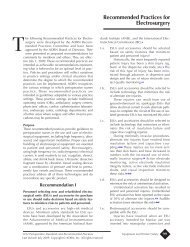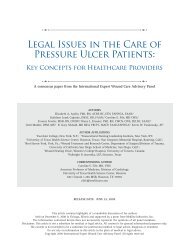VIII. Evidence ReviewQ1. Who should receive urinary catheters?To answer this question, we focused on three subquestions: A) When is urinary catheterizationnecessary? B) What are the risk factors <strong>for</strong> <strong>CAUTI</strong>? <strong>and</strong> C) What populations are at highest riskof mortality from urinary catheters?Q1A. When is urinary catheterization necessary?The available data examined five main populations. In all populations, we considered <strong>CAUTI</strong>outcomes as well as other outcomes we deemed critical to weighing the risks <strong>and</strong> benefits ofcatheterization. The evidence <strong>for</strong> this question consists of 1 systematic review, 37 9 RCTs, 38-46<strong>and</strong> 12 observational studies. 47-58 The findings of the evidence review <strong>and</strong> the grades <strong>for</strong> allimportant outcomes are shown in Evidence Review Table 1A.For operative patients, low-quality evidence suggested a benefit of avoiding urinarycatheterization. 37-44,47-49 This was based on a decreased risk of bacteriuria/unspecified UTI, noeffect on bladder injury, <strong>and</strong> increased risk of urinary retention in patients without catheters.Urinary retention in patients without catheters was specifically seen following urogenitalsurgeries. The most common surgeries studied were urogenital, gynecological, laparoscopic,<strong>and</strong> orthopedic surgeries. Our search did not reveal data on the impact of catheterization onperi-operative hemodynamic management.For incontinent patients, low-quality evidence suggested a benefit of avoiding urinarycatheterization. 45,50-52 This was based on a decreased risk of both SUTI <strong>and</strong>bacteriuria/unspecified UTI in male nursing home residents without urinary catheters comparedto those with continuous condom catheters. We found no difference in the risk of UTI betweenhaving a condom catheter only at night <strong>and</strong> having no catheter. Our search did not reveal dataon the impact of catheterization on skin breakdown.For patients with bladder outlet obstruction, very low-quality evidence suggested a benefit of aurethral stent over an indwelling catheter. 53 This was based on a reduced risk of bacteriuria inthose receiving a urethral stent. Our search did not reveal data on the impact of catheterizationversus stent placement on urinary complications.For patients with spinal cord injury, very low-quality evidence suggested a benefit of avoidingindwelling urinary catheters. 54,56 This was based on a decreased risk of SUTI <strong>and</strong> bacteriuria inthose without indwelling catheters (including patients managed with spontaneous voiding, cleanintermittent catheterization [CIC], <strong>and</strong> external striated sphincterotomy with condom catheterdrainage), as well as a lower risk of urinary complications, including hematuria, stones, <strong>and</strong>urethral injury (fistula, erosion, stricture).For children with myelomeningocele <strong>and</strong> neurogenic bladder, very low-quality evidencesuggested a benefit of CIC compared to urinary diversion or self voiding. 46,57,58 This was basedon a decreased risk of bacteriuria/unspecified UTI in patients receiving CIC compared to urinarydiversion, <strong>and</strong> a lower risk of urinary tract deterioration (defined by febrile urinary tract infection,vesicoureteral reflux, hydronephrosis, or increases in BUN or serum creatinine) compared toself-voiding <strong>and</strong> in those receiving CIC early (< 1 year of age) versus late (> 3 years of age).34
Evidence Review Table 1A. When is urinary catheterization necessary?1A.1. Use urinary catheters in operative patients only as necessary, rather than routinely.(Category IB)1A.2. Avoid use of urinary catheters in patients <strong>and</strong> nursing home residents <strong>for</strong> management ofincontinence. (Category IB)1A.2.a. Further research is needed on periodic (e.g., nighttime) use of external catheters inincontinent patients or residents <strong>and</strong> the use of catheters to prevent skin breakdown. (Norecommendation/unresolved issue)1A.3. Further research is needed on the benefit of using a urethral stent as an alternative to anindwelling catheter in selected patients with bladder outlet obstruction. (Norecommendation/unresolved issue)1A.4. Consider alternatives to chronic indwelling catheters, such as intermittent catheterization,in spinal cord injury patients. (Category II)1A.5. Consider intermittent catheterization in children with myelomeningocele <strong>and</strong> neurogenicbladder to reduce the risk of urinary tract deterioration. (Category II)Q1B. What are the risk factors <strong>for</strong> <strong>CAUTI</strong>?To answer this question, we reviewed the quality of evidence <strong>for</strong> those risk factors examined inmore than one study. We considered the critical outcomes <strong>for</strong> decision-making to be SUTI <strong>and</strong>bacteriuria. The evidence <strong>for</strong> this question consists of 11 RCTs 59-69 <strong>and</strong> 37 observationalstudies. 9,50,54,70-103 The findings of the evidence review <strong>and</strong> the grades <strong>for</strong> all important outcomesare shown in Evidence Review Table 1B.For SUTI, 50,54,61,62,74,75,79,83,102,103 low-quality evidence suggested that female sex, older age,prolonged catheterization, impaired immunity, <strong>and</strong> lack of antimicrobial exposure are riskfactors. Very low quality evidence suggested that catheter blockage <strong>and</strong> low albumin level arealso risk factors. For bacteriuria, 9,59-61,63-68,72,73,76-78,82,84-86,89-94,96-100 multiple risk factors wereidentified; there was high quality evidence <strong>for</strong> prolonged catheterization <strong>and</strong> moderate qualityevidence <strong>for</strong> female sex, positive meatal cultures, <strong>and</strong> lack of antimicrobial exposure. Lowqualityevidence also implicated the following risk factors <strong>for</strong> bacteriuria: older age,disconnection of the drainage system, diabetes, renal dysfunction, higher severity of illness,impaired immunity, placement of the catheter outside of the operating room, lower professionaltraining of the person inserting the catheter, incontinence, <strong>and</strong> being on an orthopaedic orneurology service. Our search did not reveal data on adverse events <strong>and</strong> antimicrobialresistance associated with antimicrobial use, although one observational study found that theprotective effect of antimicrobials lasted only <strong>for</strong> the first four days of catheterization, <strong>and</strong> thatantimicrobial exposure led to changes in the epidemiology of bacterial flora in the urine.35
- Page 4 and 5: AcknowledgementHICPAC thanks the fo
- Page 6 and 7: AbbreviationsADLAPACHE IIASAASBBUNC
- Page 8 and 9: I. Executive SummaryThis guideline
- Page 10 and 11: II. Summary of RecommendationsTable
- Page 12 and 13: II. Proper Techniques for Urinary C
- Page 14 and 15: 1. If obstruction is anticipated, c
- Page 16 and 17: a. Procedure-specific guidelines fo
- Page 18 and 19: III. Implementation and AuditPriori
- Page 20 and 21: IV. Recommendations for Further Res
- Page 22 and 23: V. BackgroundUrinary tract infectio
- Page 24 and 25: acteriuria inevitably occurs over t
- Page 26 and 27: VII. MethodsThis guideline was base
- Page 28 and 29: Figure 2: Results of the Study Sele
- Page 30 and 31: After determining the GRADE of the
- Page 32 and 33: Category I recommendations are defi
- Page 36 and 37: Evidence Review Table 1B. What are
- Page 38 and 39: Very low-quality evidence suggested
- Page 40 and 41: Q2B.2. Hydrophilic catheters vs. st
- Page 42 and 43: For all comparisons, we considered
- Page 44 and 45: a. Clamping vs. free drainage prior
- Page 46 and 47: studies. 3,25,260-276 The findings
- Page 48 and 49: 2D.5. Maintain unobstructed urine f
- Page 50 and 51: 15. Jain P, Parada JP, David A, Smi
- Page 52 and 53: 44. Chaudhuri P, Vengadasalam D. Ur
- Page 54 and 55: 71. Kelleher RE, Meeropol E, Parks
- Page 56 and 57: 101. Hirsh DD, Fainstein V, Musher
- Page 58 and 59: 132. Van Nagell, JR, Penny RM, Rodd
- Page 60 and 61: 163. Lai KK, Fontecchio SA, Lai KK,
- Page 62 and 63: 193. Waites KB, Canupp KC, Armstron
- Page 64 and 65: 222. Cohen A. A microbiological com
- Page 66 and 67: 253. Chavigny KH. The use of polymi
















